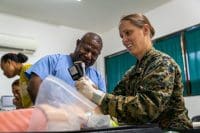Patients with ovarian cancer may receive intraperitoneal (IP) chemotherapy, which delivers chemotherapeutic agents directly into the peritoneal cavity. Drugs given by this route include paclitaxel, carboplatin, and cisplatin.
The National Cancer Institute recommends IP chemotherapy as standard treatment for stage III surgically debulked epithelial ovarian cancer. Trials by the Gynecologic Oncology Group (GOG) showed that women with advanced ovarian cancer who received IP chemotherapy survived 8 to 15.9 months longer than those who received I.V. therapy alone.
Ovarian cancer most often spreads by local tumor shedding from the ovary into the peritoneal cavity. The disease is limited largely to this space (although lymphatic spread may occur to pelvic and para-aortic lymph nodes). Thus,
IP delivery places chemotherapy drugs in direct contact with diseased tissue. (See Advantages of IP chemotherapy by clicking on the pdf icon above.) Surgical debulking before IP therapy reduces the amount of tumor, making chemotherapy more effective.
IP chemotherapy is given routinely in outpatient settings. Nurses who administer it need special training. This article gives an overview of IP therapy and the nurse’s role.
Types of ports and their placement
An access device must be placed to deliver IP therapy. (Although a short-term cannula may be used without surgical intervention, it may become dislodged or lead to chemotherapy leakage around the site.) IP ports have a slightly larger diameter and a higher profile than Port-a-Caths. Also, catheters on IP ports may be fenestrated with multiple openings at the end, whereas venous ports have just one opening at the catheter tip.
The port head is inserted into a subcutaneous tissue pocket beneath the skin and sutured in place over the lowest rib; during needle access, the rib serves as a hard surface for supporting the port. The catheter has one or more Dacron cuffs, which may be sutured or allowed to adhere to the fascia to secure it in place. The catheter’s distal end floats freely in the peritoneal space; the port head contains a silicone septum where the needle is inserted. Chemotherapeutic drugs enter the port septum, flow through the catheter, and drain into the peritoneal space. As they bathe the entire cavity, they destroy cancer cells throughout. (See Picturing an IP port by clicking on the pdf icon above.)
Complications of port placement include infection, sideways tilting or flipping of the port if a suture breaks, catheter disconnection from the port head, and port retraction (rare).
IP ports may be used to deliver drugs within a few days of placement. However, patients requiring colon resection during initial tumor debulking should be allowed to heal for 6 weeks before port placement to permit clearance of bowel organisms that could cause infection.
Port access
Before chemotherapy begins, inspect the port insertion site for redness and ask the patient about increased pain. These findings could indicate infection.
Using sterile technique, access the port with a port-specific, angled noncoring needle. For optimal flow, use a 19G or 20G needle. (Other types of needles remove or “core” the silicone in the septum with each access, limiting port longevity.) Unlike with a port whose catheter is inserted I.V. into a major vein, blood return does not appear when an IP port is accessed; the catheter tip floats freely in the peritoneal fluid (which you may or may not aspirate). The port should flush easily and flow to gravity freely.
Administering chemotherapy
For easiest port access, position the patient lying down with her head at a 30-degree angle or sitting in a reclining chair to enhance drug distribution throughout the peritoneal space. Some facilities prefer a slight Trendelenburg position because diaphragmatic seeding by ovarian cancer cells is common. Although this position gives the drug more contact with the diaphragm, it may cause discomfort by placing more pressure on the diaphragm; if using it, assess your patient’s tolerance.
Treatment duration varies. Administration of IP chemotherapy alone may take only 1 to 2 hours. With concurrent I.V. chemotherapy, treatment may take longer.
Giving fluids
As ordered, give sufficient fluids (approximately 1 to 3 L) to optimize drug distribution and exposure throughout the entire peritoneal cavity. IP fluid may be warmed using a water bath to help prevent the chilling that some patients experience when given cool fluid. But be aware that no evidence supports the superiority of giving warmed fluid. Warming is for patient comfort and isn’t practiced at all facilities.
Keep blankets readily available for all patients. Also, know that because of the large fluid volumes given, patients may need to urinate frequently.
In all clinical trials demonstrating improved response to IP chemotherapy, 2 L of normal saline solution (NSS) was delivered into the peritoneal cavity. This amount may cause abdominal distention and discomfort. Most patients tolerate the fluid without significant vital-sign changes, but if your patient has difficulty, consider decreasing the flow rate. Occasionally, patients can’t tolerate the entire recommended volume; adjustments should be made on an individual basis.
Nursing considerations
- If your patient complains of pain or burning or if edema occurs at the port site during infusion, suspect fluid has infused into subcutaneous tissue instead of the port. Stop the infusion immediately, check for proper needle placement, and notify the physician.
- Apply a transparent dressing after access over the insertion site to allow visualization of the needle and to help secure it.
- Have the patient turn during treatment so the drug can disperse throughout the peritoneal cavity. The typical turning schedule is every 15 minutes. Instruct the patient to turn to her right side, her left side, and then onto her back repetitively until treatment ends. (At some facilities, patients are instructed to start turning every 15 minutes for 1 hour after the infusion ends.)
- Advise a patient who will turn or ambulate during the infusion to place a hand over the port dressing and apply light pressure to keep the needle intact.
- Be aware that after IP chemotherapy, more fluids may be given IP to increase drug distribution. (See Key patient-care considerations by clicking on the pdf icon above.)
Post-treatment management
When therapy is completed, flush the IP port with NSS or heparin, using the volumes and concentrations specified by your facility. Although the catheter of the port doesn’t rest in a blood vessel, the hemorrhagic nature of ovarian cancer commonly causes mixing of blood with peritoneal fluid, which can lead to clotting of the catheter.
At some treatment centers, tissue plasminogen activator is used if the port doesn’t flush. However, these ports should be evaluated by flow study. Definitive research on the benefits of heparin in keeping IP ports open isn’t available. But because ovarian cancer tends to be hemorrhagic, some centers have found heparin helpful in reducing clotting and blockage of the catheter. Thus, some facilities have a policy on whether to use heparin flush or NSS. Retrospective data collection is needed to identify the number of patients with IP ports and the associated complication rate.
The procedure for decannulation (needle removal) from the IP port is the same as for a venous port. The port itself may be removed as an outpatient surgical procedure after all chemotherapy treatment cycles are completed.
Dealing with adverse effects
Learn about possible adverse effects of IP chemotherapy. Assess the patient’s tolerance to the previous treatment course. Find out what adverse effects she already has had. As ordered and needed, give supportive drugs and fluids.
Know that when given IP, paclitaxel, carboplatin, and cisplatin may cause neurotoxicity, hypersensitivity reactions (with the first paclitaxel dose or after the seventh carboplatin dose), nephrotoxicity, and delayed nausea and vomiting (with cisplatin). Paclitaxel and cisplatin are highly neurotoxic; the latest trial data indicate peripheral neurotoxicity may be more severe with IP than I.V. therapy. However, within 1 year, toxicity decreases to levels seen with I.V. therapy.
The nurse’s role
Nurses who manage patients who receive IP chemotherapy require special training and skills, including:
- IP port placement and access
- chemotherapy agents used and their adverse effects
- administration of IP chemotherapy
- management of complications.
Nurses also play a vital role in educating patients and their families at all treatment stages. Before every treatment session, reassess the patient’s knowledge of the disease and treatment. Under the duress of cancer and its treatment, patients may miss or forget important information. So whenever possible, provide written material with illustrations for them to refer to at home. Reinforce all teaching to decrease anxiety, ensure safety, and increase compliance.
Although the Oncology Nursing Society doesn’t offer specialty education or certification in IP chemotherapy administration, the GOG website provides information. At this time, training and certification in IP chemotherapy administration are largely facility specific.
Selected references
Alberts D, Liu PY, Hannigan EV, et al. Intraperitoneal cisplatin plus intravenous cyclophosphamide versus cisplatin plus intravenous cyclophosphamide for stage III ovarian cancer. N Engl J Med. 1996;335:1950-1955.
Almadrones L. Evidence-based research for intraperitoneal chemotherapy in epithelial ovarian cancer. Clin J Oncol Nurs. 2007;11(2);221-215.
Armstrong DK, Bundy B, Wenzel L, et al. Intraperitoneal cisplatin and paclitaxel in ovarian cancer. N Engl J Med. 2006;354:34-43.
Dedrick RL, Myers CE, Bungay PM, Devita VT Jr. Pharmacokinetic rationale for peritoneal drug administration in the treatment of ovarian cancer. Cancer Treat Rep. 1978;62(1):1-11.
Fung-Kee-Fung M, Provencher D, Rosen B, et al. Intraperitoneal chemotherapy for patients with advanced ovarian cancer: A review of the evidence and standards for the delivery of care. Gynecol Oncol. 2007;5(3):747-756. doi:10.1016/j.ygyno.2007.02.015.
Holmes R, O’Conner K, Orpen M. Meet the experts of intraperitoneal (IP) therapy: A question & answer session. J Gynecol Oncol Nurs. 2007;17(2):7-9.
Howell SB, Pfeifle CL, Wung WE, et al. Intraperitoneal cisplatin with systemic thiosulfate protection. Ann Intern Med. 1982;97:845-851.
Hydzik C. Implementation of intraperitoneal chemotherapy for the treatment of ovarian cancer. Clin J Oncol Nurs. 2007;11(2):221-225.
Jabback K, Johnson N. Intraperitoneal chemotherapy for the initial management of primary epithelial ovarian cancer. Cochrane Database Syst Rev. 2006;25(1):CD005340.
Jaffe J, Armstrong D. IP therapy in front-line care for advanced ovarian cancer: The Hess/Alberts article reviewed. Oncology. 2007;21(2):239-241. www.psychiatrictimes.com/display/article/10165/59288?pageNumber=2&verify=0. Accessed March 11, 2010.
Markman M, Walker J. Intraperitoneal chemotherapy of ovarian cancer: A review, with a focus on practical aspects of treatment. J Clin Oncol. 2006;24(6):988-994.
National Comprehensive Cancer Network. NCCN clinical practice guidelines in oncology. Ovarian cancer (V.I.2007). http://www.nccn.org/professionals/physician_gls/PDF/ovarian.pdf. Accessed March 11, 2010.
Polovich M, White JO, Kelleher L. Chemotherapy and Biotherapy Guidelines and Recommendations for Practice. 2nd ed. Pittsburgh, PA: Oncology Nursing Society; 2005:18-35.
Diana Karius is a Clinical Nurse Specialist in hematology, oncology, and palliative medicine at Cleveland Clinic in Cleveland, Ohio.

















